There are approximately 34,000 known fish species throughout the world which live in either fresh or saltwater environments. They are cold-blooded animals but only the opah (Lampris guttatus) is warm-blooded fish which is also known as cravo, kingfish, moonfish, and Jerusalem haddock.
There are two main groups of fish, namely Chondrichthyes and Osteichthyes based on the composition of the endoskeleton. The endoskeleton of Chondrichthyes is made up of cartilages and they mainly live in marine habitats while the endoskeleton of Osteichthyes is composed of bones which are found in both marine and freshwater habitats.
Chondrichthyes
It is a diverse group which contains more than 700 species, found throughout the world’s marine environments. This group includes the sharks, rays, and skates, and their skeleton is made up by rubbery cartilage, which is very light and flexible. The world`s largest member of Chondrichthyes is the plankton-feeding whale sharks (Rhincodon typus) which can grow up to 18 meters (60 feet) in length with 21.5 tonnes in weight and live up to 130 years. The main characteristics of chondrichthyans fish include jaws, paired fins, paired nostrils, placoid scales, and two-chambered hearts.
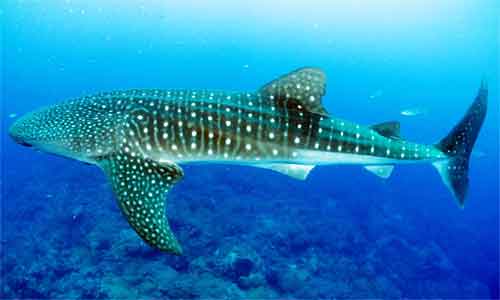

whale sharks (Rhincodon typus)
General Characteristics of Chondrichthyes
- The body is covered by tough skin with minute placoid scale and mucous glands.
- They have jaws and paired appendages.
- They lack the air-filled swim bladder.
- They have median and paired fins which are supported by cartilaginous fin rays.
- The mouth is ventrally placed with rows of teeth.
- They have heterocercal type caudal fin.
- They have a well-developed electroreceptive system.
- They have 5-7 pairs of gills for performing respiration with no operculum.
- The male members of Chondrichthyes have specialized paired intromittent organs or reproductive organs at the inner edge of the pelvic fins which is known as clasper.
- They may be oviparous (egg layers), viviparous (live-bearer) or some species are ovoviviparous (mother carry eggs in her body).
- They produce large-sized yolky eggs and their fertilization is internal with direct development.
- The digestive system consists of a j-shaped stomach and short intestine with a spiral valve.
- The fish bears one or two nostrils which never opens in the mouth cavity.
- The heart bears a contractile conus arteriosus with rows of valves.
- They have typically paired gonads and gonoducts which open into the cloaca.
- Most Chondrichthyes exhibit a massive growth with up to 21.5 tonnes in weight (whale shark).
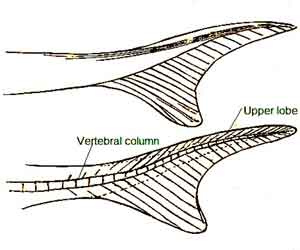

Heterocercal tail
The class Chondrichthyes is divided into the following two subclasses:
- Subclass-1: Elasmobranchii (sharks, rays, skates, and sawfish) and
- Subclass-2: Holocephali (chimaeras)
Characteristics of subclass Elasmobranchii
- The members of the Elasmobranchii have no swim bladders.
- They have 5-7 pairs of gill clefts which open individually to the exterior.
- They have a rigid type of dorsal fins.
- The body is covered with small placoid scales.
- A tapetum lucidum tissue layer is present in the eyes.
- The male members bear reproductive organs at the inner edge of each pelvic fin for the transmission of sperm which is known as clasper.
Examples: Sharks, rays, and skates.
Characteristics of Subclass Holocephali
- They have a cartilaginous skeleton with high compressed head and small narrow mouth which gives the head a parrot-like appearance.
- They have a thin and long tail with large pectoral fins.
- The front side of the dorsal fin bears an erectile spine.
- They have simplified gut with no stomach where the stomach is merged with the intestine.
- The gill clefts are covered by a fold of skin.
- In nature, they inhabit close to the bottom and their foods mainly consist of mollusks and other invertebrates.
Examples: Rat fishes (Chimaera), rabbit-fishes (Hydrolagus) and elephant-fishes (Callorhynchus).
You might also read: Fish Fins: Types, Modification and Functions
Osteichthyes
It is the largest class of subphylum Vertebrata which contains approximately 28,000 known species that comprise 96% of all fishes. At the embryonic stage, the endoskeleton is cartilaginous but in the adult stage, endoskeleton is replaced by a bony skeleton. They live in both marine and freshwater environments. The largest bony fish is the ocean sunfish or common mola (Mola mola) in the world, which grows up to 2.3 meters in length and 2300 kg in weight while the smallest fish is the dwarf pygmy goby (Pandaka pygmaea) which can grow up to 9 mm (female) and 15 mm (male) in length. Class Osteichthyes has two groups: ray-finned and lobe-finned fish where the ray-finned fish bears a single dorsal fin while lobe-finned fish bears two dorsal fins.
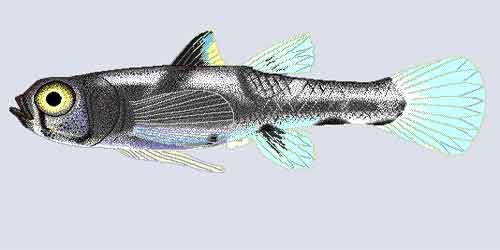

Dwarf pygmy goby (Pandaka pygmaea)
General Characteristics of Osteichthyes
- The body is rounded and tapered at the ends (fusiform body).
- They bear paired (pectoral and pelvic fins) and unpaired fins (dorsal, anal, and tail fins).
- The endoskeleton is made up of bones.
- They are found in either marine or freshwater habitats.
- The caudal or tail fin is homocercal type.
- They have 4 pairs of gills or breathing organs which are covered by the gill covers or the operculum on each side.
- They have sac-like outgrowth which is known as swim bladder or air bladder that also acts as a hydrostatic organ. It arises from the dorsal wall of the esophagus which is used to maintain balance and to swim up and down.
- The exoskeleton is dermal in origin if present which is composed of cycloid, ctenoid or ganoid scales
- They possess a terminal mouth which is located at the anterior tip of the body.
- They have well developed lateral line system which runs through the body and consists of a series of sensory organs, called neuromasts that help to sense both water pressure and vibrations.
- Digestive tract leads into the anus with no cloaca.
- They have well-developed eyes with the nictitating membrane.
- Generally, their fertilization is external with direct development. Most of the fishes are oviparous but some are ovoviviparous.
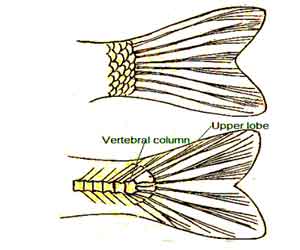

Homocercal tail
Examples: Cyprinids, Perches, flying fish, globefish, sea horses and eels, etc.
Living Osteichthyes are divided into the following three subclasses:
- Subclass-1: Dipnoi
- Subclass-2: Crossopterygii, and
- Subclass-3: Actinopterygii.
Characteristics of subclass Dipnoi
- This subclass contains 6 extant species under two orders: Ceratodontiforms and Lepidosireniformes.
- They are also known as lungfishes.
- The largest lungfish is the African lungfish which can reach up to 2 m (6.6 ft) in length and 50 kg (110 lb) in weight.
- They have an air-breathing organ which opens to the esophagus.
- They have long and tubular pelvic and pectoral fins.
- Its dorsal and anal fins are fused with caudal fin.
- The upper jaw is fused to the braincase with fused teeth.
- They are omnivorous and their foods consist of fish, insects, worms, crustaceans, mollusks, amphibians and plant matter, etc.
- Their digestive tract contains an intestinal spiral valve.
Examples: Australian lungfish (Neoceratodus forsteri) South American lungfish (Lepidosiren paradoxa), West African lungfish (Protopterus annectens), etc,
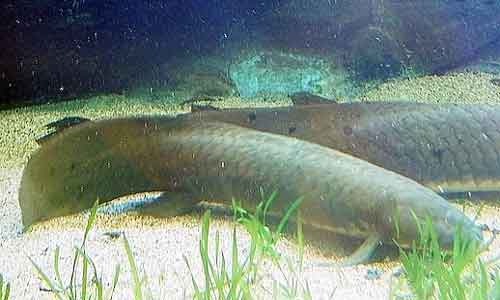

Characteristics of subclass- Crossopterygii
- They are also known as lobe-fined fishes.
- They have typically paired fins which act as support against the floor of the water body.
- All fins have movable lobes or stalks.
- The caudal fin is either diphycercal or heterocercal types.
- They have two dorsal fins with separate bases.
- The largest member of this subclass is the West Indian Ocean coelacanth which can grow up to 2 m (6 ft 7 in) in length and 110 kg (240 lb) in weight.
Example: Coelocanth (Latimeria chalumnae)
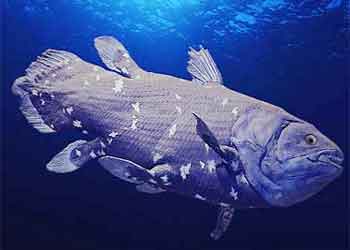

Coelocanth
Subclass-Actinopterygii
The members of the subclass Actinopterygii are known as ray-finned fishes. They are the most diverse and the largest group of fishes with a wide variety of shapes, sizes, and colors which comprises half of all the living vertebrates. There are approximately 24,000 known species under 42 orders with 431 families. Among them, Teleosts comprise approximately 23,000 species and 96% of all living fish species.
Characteristics of subclass Actinopterygii
- The fins are supported by rays or spines which give the name ‘actinopterygians’.
- The unique features of the ray-finned fish is the swim bladder which helps them to move up or down in the water body.
- The gills are covered by an operculum and the fish perform respiration through gills.
- They inhabit a variety of environments such as marine and freshwater within 1 to 7000 m depth ranges.
- They have different types of scales such as ganoid and laptoid scales (cycloid and ctenoid).
- They have branchiostegal rays which are originated from the bones at the base of the branchial cavity.
- They have homocercal tail fin where the upper and lower lobes are the same length.
Examples: The most familiar fish species of Actinopterygii includes, sturgeons, anchovies, gars, eels, bass, carp, herrings, cichlids, catfishes, oarfish, goldfishes, pickerel, piranhas, seahorses, salmon, trout, etc.


Seahorse
Difference Between Chondrichthyes and Osteichthyes
|
Key Features |
Chondrichthyes |
Osteichthyes |
|
Common names |
They are also known as cartilaginous fishes. |
They are also known as bony fishes. |
|
Habitat |
They inhabit in the marine environment. Sometimes many cartilaginous fishes enter into freshwater environments. |
They inhabit in both marine and freshwater environments |
|
Endoskeleton |
Endoskeleton is made up by the cartilage. |
Endoskeleton is made up by bones. |
|
Scale types |
The body is covered by very small denticles, known as placoid scales. |
If present, scales are various types such as ganoid and laptoid scales (cycloid and ctenoid). |
|
Generally, they have a large–sized body. |
Comparatively, they are small-sized fish. |
|
|
Mouth position |
They have ventrally situated mouth. |
Their mouth is located at the anterior tip of the body. This type of mouth is known as terminal mouth. |
|
Numbers of Gills |
They have 5-7 pairs of gills. |
They have 4 pairs of gills. |
|
Gill cover or operculum |
The gills are not covered by gill cover or operculum. |
The gills are covered by an operculum on each side. |
|
Swim bladder |
They do not have swim bladders. |
They have swim bladder for buoyancy. It is also known as air bladder or gas bladder. |
|
Caudal fin |
They have heterocercal type caudal fin. In this case, lobes are not equal. |
They have homocercal type caudal or tail fin. In this case, both lobes are equal in size. |
|
Fertilization |
In many cases, internal fertilization occurs. |
In most cases, external fertilization occurs. |
|
Excretory products |
Their excretory products are urea (CH4N2O) |
Their excretory products are mainly ammonia (NH3). |
|
Feeding behavior |
Generally, they are carnivores in nature. |
They may be omnivores, carnivores, herbivores, filter-feeders or detritivores. |
|
Examples |
Skates, sharks, and rays. |
Tuna, Dolphin fish, Barramundi, Salmon fish, trout, rohu, seahorse, etc. |
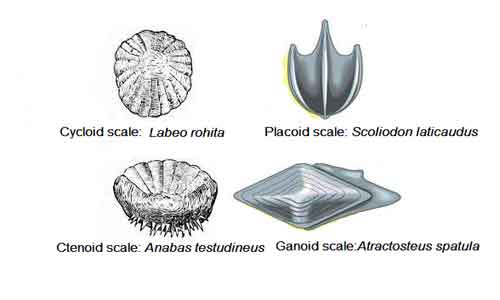

Different types of scales
Concluding Remarks
Fish are the cold-blooded aquatic organisms which belong to the subphylum Vertebrata of phylum Chordata. There are two main groups of fish based on the endoskeleton, namely Chondrichthyes and Osteichthyes. The endoskeleton of the members of Chondrichthyes is made up of cartilage while the endoskeleton of fish under the class Osteichthyes is composed of bones.
Fish are very important to human beings because they provide nutrients and micronutrients. These nutrients are essential for the physical development of children. It is also an important part of a healthy diet of all stages of people and controls many diseases. They are an important source of income and employment for the people of many developing countries.
At present, 1245 (8.1%) fish species are listed as vulnerable (IUCN). Among them, 121 species belong to the cartilaginous fish and 1114 species are ray-finned fish. Fish become vulnerable due to pollution, habitat destruction, diseases, over-exploitation, etc. To protect our fish species, we should take proper conservation measures.

